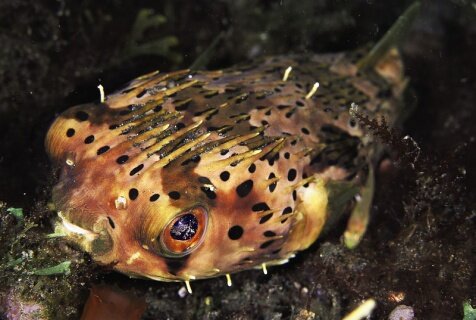Spiny Puffer
From Microcosm Aquarium Explorer

A species that can easily become a family pet. Scott W. Michael
Overview
A comical-looking species with a wonderful personality, these inflatable fish make fascinating pets. They are greedy eaters, rising up to take food from their keepers’ fingers.
Family: Diodontidae
Other common name(s):
- Porcupinefish
- Balloon Porcupinefish
- Longspine Porcupinefish
Native range:
- Circumtropical
- Florida
- Bahamas
- Brazil
- South Africa
- Eastern Atlantic
- Red Sea
- Madagascar
- Reunion Island
- Mauritius
- Japan
- Lord Howe Island
- Hawaii
- Easter Island
- California
- Galapagos Islands
- Colombia
Habitat: Reef or reef-sand interface, lagoons and seagrass beds. Provide ample swimming space as well a rocky hiding places.
Maximum length: 30 cm (12 in)
Minimum aquarium size: 285 L (75 gal)
Water: Marine 24 °C (75 °F) - 28 °C (82 °F)
General swimming level: All levels.
Feeding
Omnivore, but primarily a carnivore in the wild. Feed meaty and herbivore foods twice a day.
Aquarium Compatibility
These puffers are not typically a threat to other fishes. However, they may nip at those species with elaborate finnage, fishes that resemble the substrate or species that cannot move very fast. They do not usually bother one another, although it is best to add them to the tank all at once. This fish is a potential threat to a number of different invertebrates, including worms, snails, clams, sea stars and sea urchins. It can be kept with unpalatable soft corals.
Breeding/Propagation
Egg scatterers that produce pelagic eggs, often in midwater mating rituals. Both eggs and larvae that drift with plankton in the water column and settle back onto a reef at about the time of metamorphosis. These are among the most challenging types of marine fishes to propagate in captivity.
Notes
The Spiny Puffer spends much of its time resting on the substrate or begging for food. Once it learns to associate its keeper with food, it will swim along the front glass and eye the aquarist as he or she approaches the aquarium. When threatened or sometimes for no apparent reason, these fish will inflate with water. If they are out of the water, they may inflate with air, which can be lethal, as the fish may have difficulty expelling the ingested air. Never remove a puffer from the water to see it inflate.








